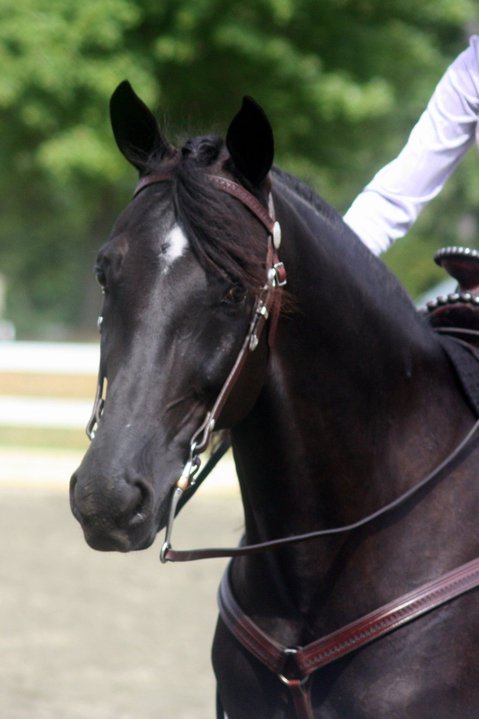I have been the lucky owner of a fabulous OTSTB (Off Track Standardbred) for 13 years. Contrary to popular misconception, Standardbreds are capable of beauty, trainability, versatility, and purpose beyond harness racing. Yes, they can be ridden, they can jump, and they can canter! Some, like my wonderful mare, Veruca Salt, can even lope as nicely as any Quarter Horse! I came to own Veruca Salt (aka Legs) out of sheer luck. She was barely 3 years old, untalented at pacing, and lacking much of an apparent future. I was in college, out of state, and not in a great financial position to own my first horse. Thankfully, through accommodating parents and a whole lot of luck, our story ended up quite well. Rather than rehash our life together, those who want to know more can find information here: http://xwebapp.ustrotting.com/absolutenm/templates/?a=38042&z=13
Suffice to say, my little mare has exceeded my wildest dreams for her. Starting from very inauspicious beginnings, she is the proverbial free horse turned champion, having earned over 175 blue ribbons (closing in on 200 soon), numerous championships, show series awards, state year end awards, multiple gold, silver, and bronze medals at the Bluegrass State Games, and many national championships. She has won repeat National Championships and Reserve Championships in Western Pleasure, English Pleasure, Equitation, and Working Hunter. She has been the Standardbred National Championship Horse Show High Point Senior Horse each of the three years we've attended the show, as well as the 2008 High Point Grand Champion Standardbred in the Nation. There is practically no discipline that she won't try for me, and quite successfully at that!
Besides her show career, she has also been an Intercollegiate Horse Show Association mount in flat, fences, rail, and reining, including carrying a rider to the IHSA Intermediate Western Horsemanship Reserve National Championship in 2004, and she spent a year as a handicapped riding horse at Central Kentucky Riding for Hope. She was the only non-stock horse used in the western divisions. The icing on the cake was being 1 of only 8 Standardbreds from across the country chosen to exhibit at the 2010 World Equestrian Games in Lexington, Kentucky. She is beautiful, intelligent, versatile, and easy to work with, and I know how lucky I am to have her. She's 16 now, and has served me faithfully. Early stages of foot problems are now beginning to slow down our competitive career; thus, I have been searching for a second horse to supplement (there's no replacing Legs!) her.
Around 2004, I had aspirations to compete at horse shows on a national level. At that time, I was not aware of the existence of state Standardbred Pleasure Horse Organizations (SPHOs), or the National Standardbred Horse Show, and felt that my best option was a more "traditional" versatility breed such as the Quarter Horse. Being well aware of the constant travel, expenses, and politics associated with showing AQHA at a high level, I focused my search on color breed organizations, such as PHBA and ABRA.
After a few unsuccessful endeavors at purchasing such a horse, I thought I had found the right one in 2006. He was a palomino yearling colt I found at a horse trader's: unbroke, with a string of 4 owners over just 18 months of life, but nicely proportioned and good natured. I took my time working with him and he was my pride and joy. Unfortunately, when it came time to progress with his under saddle training, it became apparent that he had latent physical problems. After 2 years of money, time, and effort attempting to diagnose and rehab him, I became clear that he had a long term chronic hip problem. Though he was sound for light riding, I knew it would not be fair to expect him to compete at the levels I aspired to. At the same time, I knew with his sweet disposition, he could be much more than a pasture pet. I was fortunate to find him a great home as a companion and light riding horse where I could keep in touch with how he's doing and even visit him.
In the meantime, I had confirmed that there were, indeed, other nice Standardbreds for riding and show use. I had found the SPHO program, first participating with the Ohio chapter, and later, finding the New Jersey chapter. My very brief experience with PHBA sanctioned shows had been a bit underwhelming (the people were nice enough, but the shows seemed oriented for chasing points rather than having fun), while my Standardbred show experience had been quite positive; I decided that another Standardbred seemed like the right ticket. The SPHO NJ offered a first rate National Show, great competition, great year end prizes, and other nice folks who were passionate about STBs and their capabilities. Thus, I was hopeful that I would find my next STB superstar through my contacts there.

No comments:
Post a Comment